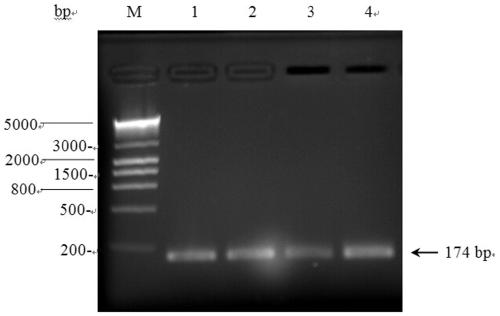Construction of a tomato psy 1 gene CRISPR-Cas9 system and its application
A tomato, gene technology, applied in the field of genetic engineering and genetic modification
- Summary
- Abstract
- Description
- Claims
- Application Information
AI Technical Summary
Problems solved by technology
Method used
Image
Examples
Embodiment 1
[0028] Example 1: tomato PSY 1 sgRNA design for gene CRISPR-Cas9
[0029] 1. Find the PAM (proto adjacent motif) motif
[0030] exist PSY 1 The PAM motif, namely NGG, was found in the first exon region of the gene sequence.
[0031] 2. Determine the sgRNA sequence
[0032] The 20 bp sequence at the 5' end of the PAM position is the sgRNA sequence. Generally, the U6 promoter is used in tomato CRISPR-Cas9 to transcribe the sgRNA, so the 20 bases at the 5' end of NGG are preferentially G, that is, G(N) 19 NGG. tomato PSY 1 The sgRNA sequence of the first exon region of the gene is shown in SEQ ID NO.1.
[0033] 3. sgRNA primer synthesis
[0034] The sequences are shown in SEQ ID NO. 2 and SEQ ID NO. 3, respectively.
[0035] 4. sgRNA amplification reaction system
[0036] Add deionized water to the synthesized primers to make the concentration 10 μM, and then prepare the sgRNA amplification reaction system as follows:
[0037]
[0038] 5. sgRNA amplification reaction c...
Embodiment 2
[0042] Example 2: Tomato PSY 1 gene sgRNA connected to CRISPR-Cas9 Level 1 carrier
[0043] 1. Purification of sgRNA amplification products
[0044] Using GenElut TM PCR Clean-Up Kit (SIGMA) was used to purify PCR products.
[0045] 2. CRISPR-Cas9 Level 1 ligation reaction system
[0046]
[0047] 3. CRISPR-Cas9 Level 1 ligation reaction conditions
[0048]
[0049] 4. Transform the ligation product into E. coli
[0050] Take 40 μL of Escherichia coli DH5α (DH8142) competent cells and mix with 5 μL of Level 1 ligation product, and put them in ice bath for 15 min, then in water bath at 42°C for 45 s, and then in ice bath for 5 min. Then add 600 μL of LB medium, shake and culture at 37°C for 1.5 h. Pipette 100 μL of culture solution and spread evenly on LB plate (containing 100 mg·L -1 Xgal and 100 mg·L -1 Carbenicilin) and incubated overnight at 37°C.
[0051] 5. Select monoclonal shaking bacteria
[0052] Select the white monoclonal colony on the LB plate and...
Embodiment 3
[0058] Example 3 Tomato PSY 1 gene sgRNA connected to CRISPR-Cas9 Level 2 vector
[0059] 1. CRISPR-Cas9 Level 2 ligation reaction system
[0060]
[0061] 2. CRISPR-Cas9 Level 2 ligation reaction conditions
[0062]
[0063] 3. Transform the ligation product into E. coli
[0064] Take 40 μL of Escherichia coli DH5α (DH8142) competent cells and mix with 5 μL of Level 2 ligation product, and put them in ice bath for 15 min, then in water bath at 42°C for 45 s, and then in ice bath for 5 min. Then add 600 μL of LB medium, shake and culture at 37°C for 2 h. Pipette 100 μL of culture solution and spread evenly on LB plate (containing 100 mg·L -1 Kanamycin) at 37°C overnight.
[0065] 4. Select monoclonal shaking bacteria
[0066] On the LB plate, pick the white monoclonal into 10 mL LB medium (containing 100 mg·L -1 Kanamycin), cultured overnight at 37°C. 3shown. PCR program: 98°C, 30 s; 94°C, 10 s; 60°C, 30 s; 72°C, 30 s; 35 cycles; 72°C, 2min; 4°C, Hold.
[0067] ...
PUM
 Login to View More
Login to View More Abstract
Description
Claims
Application Information
 Login to View More
Login to View More - R&D
- Intellectual Property
- Life Sciences
- Materials
- Tech Scout
- Unparalleled Data Quality
- Higher Quality Content
- 60% Fewer Hallucinations
Browse by: Latest US Patents, China's latest patents, Technical Efficacy Thesaurus, Application Domain, Technology Topic, Popular Technical Reports.
© 2025 PatSnap. All rights reserved.Legal|Privacy policy|Modern Slavery Act Transparency Statement|Sitemap|About US| Contact US: help@patsnap.com



